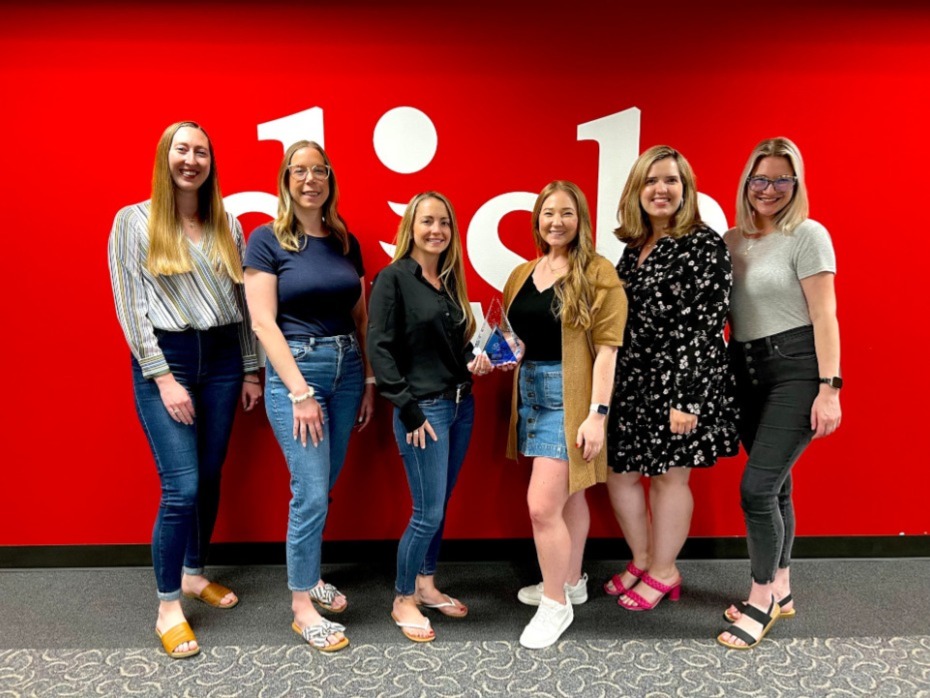The DISH Network’s University Relations team is intentional in attracting top college students to deliver a valuable experience for both interns and the company.
“Our recruiters seek out high-potential candidates through well-established recruiting and sourcing strategies,” explains Randi Keller, DISH University Relations manager.
“Aspiring to convert our highly successful interns to full-time employees upon graduation, our team views the recruitment process as a long-term investment. DISH’s successful intern-to-full-time hire conversion rate is achieved because of the strategic approach to DISH’s recruitment process intended to ‘recruit once, hire twice.’ This talent pipeline is a legacy that has supported the high-caliber employees DISH prides itself on.”
NACE AWARD WINNER
DISH Network is the large-employer winner of the 2023 NACE Award for Recruiting Excellence for its “Recruit Once, Hire Twice” college recruiting process. For more information about the NACE Awards program and the full list of award winners/honorable mentions, see www.naceweb.org/about-us/nace-awards/.DISH has a long history in satellite television and has also expanded into other industries with Sling TV, Boost Mobile, OnTech Smart Services, and its 5G wireless build-out.
“At DISH, we have ambitious goals and to achieve them, we need to continue to adapt to attract and retain top talent,” Keller points out.
“We found that merely attending careers fairs at local universities was no longer pushing our program forward, so we have established a strong partnership with the employment branding team to broaden our scope to make students aware of the full suite of opportunities at DISH.”
Identifying and Achieving Program Objectives
Keller explains that, historically, the DISH University Relations team was looking at different data points to drive their strategy and decision making, not replicating the same data-collection process as its talent acquisition partners. While mapping the key data points, the university relations team identified three program objectives:
- Increase the total number of applicants for internship roles;
- Enhance the quality of its intern applicants; and
- Maintain a high intern-to full-time-offer conversion rate.
“Recognizing that students were unfamiliar with the future of DISH, we targeted a 20% increase in total intern applicants through personalized messaging and new marketing channels to help students identify all lines of business under the DISH name,” Keller notes.
“Even while increasing our candidate pool, we did not want to compromise the quality of our candidates. Our recruiters’ efforts were focused on screening candidates who would be a culture-add to the company and the teams they would support.”
The outreach and campaigns on DISH’s digital platform were sent to students who met application thresholds established by program thresholds, such as a 3.0 GPA, specific skills, certain degrees, and location preference.
“Through this deliberate recruiting and matching process, we saw a high full-time conversion rate of 70% acceptance of offers extended,” Keller says.
“The recruiting process did not conclude with an intern offer as recruiters remain engaged with interns up until they start with us and over the 10-week program in order to then extend a full-time employment offer upon graduation.”
A strategic and intentional recruiting process led DISH University Relations to improve each of its identified objectives. To address the total number of applicants, DISH leveraged its digital platforms to increase its virtual and online presence.
“We drafted targeted messaging to engage with students and spark their interest in DISH before attending in-person or virtual career fairs,” Keller says.
“While increasing the total number of applicants, we didn’t want to lose the quality of our candidates.”
The company’s informal information sessions—“Dish on DISH”—became an integral part of its recruiting practices to ensure that candidates were well-informed as they began the interview process.
“After these information sessions, students became better prepared for the phone screen and questionnaires,” Keller explains.
“This allowed us to quickly identify exceptional candidates and move them into the next stages of the interview process. Our panel interviews became an opportunity for students to meet with multiple hiring teams and understand different areas of the business.”
In addition, DISH University Relations designed a “matching process,” through which the team gathers feedback from the hiring teams and the candidates to connect candidates with the teams that best match their skill sets and interests.
“This unique practice increases our conversion of interns to full-time employees,” Keller notes.
“If a hiring team is unable to offer a full-time role due to headcount at the conclusion of the internship program, we replicate the matching process in order to retain high-performing interns within the company.”
Assessing the Program’s Impact
DISH University Relations uses its applicant tracking system to review its total applicants and compare numbers year over year. For example, in fall 2021, DISH collected approximately 1,500 applications across all intern positions. This increased to more than 5,500 in fall 2022.
“By better preparing the candidates for the questionnaires, we filtered higher-quality candidates to our hiring teams,” Keller says.
“This resulted in an increase in university relations hires representing top-talent according to annual performance assessments.”
Internal data reflected 60% of the DISH University Relations hires were rated as top talent, compared to 29% of those hired by the company at large. Additionally, university relations hires averaged a higher performance assessment score by 5.4 points. In the past decade, intern conversion rates ranged from 30% to 48%. There were slight increases year over year leading up to 68% in 2021.
“By 2022, we surpassed our goal of 70% acceptance rate with a final acceptance rate of 73%,” says Keller, adding that DISH is planning to use the elements that led to the success of this initiative to construct a new graduate rotational program.
“This increase is attributed to the significant adjustments to our recruitment and matching processes that were designed through our intention to ‘recruit once, hire twice.’”






